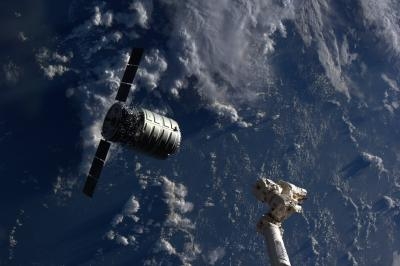Tue, Oct 01, 2013
Astronauts Capture Cygnus Spacecraft, Dock It To ISS
Astronauts aboard the International Space Station (ISS) used a robotic arm to capture and attach a Cygnus cargo resupply spacecraft Sunday, marking several spaceflight firsts for NASA and its partner, Orbital Sciences Corp. of Dulles, VA.

The station's Expedition 37 crew reported the spacecraft -- loaded with about 1,300 pounds of cargo -- berthed at 0844 EDT, following an 11-day journey to the orbiting laboratory. Orbital's Cygnus was launched on the company's Antares rocket on Sept. 18 from the Mid-Atlantic Regional Spaceport Pad-0A at NASA’s Wallops Flight Facility in Virginia. This was the first flight of a spacecraft to the space station from the state. The maiden flight of Cygnus included a number of systems tests prior to rendezvous with the station. The cargo includes student experiments, food and clothing, which will be unloaded by the station crew following hatch opening Monday.
"Orbital joins SpaceX in fulfilling the promise of American innovation to maintain America's leadership in space. As commercial partners demonstrate their new systems for reaching the Station, we at NASA continue to focus on the technologies to reach an asteroid and Mars," said NASA administrator Charles Bolden. "The international crews aboard the station are working hard on the science and technology demonstrations to help us reach new destinations, and the expanded cargo transportation capability Orbital has now demonstrated strengthens that work."
Future Cygnus flights will ensure a robust national capability to deliver critical science research to orbit, significantly increasing NASA's ability to conduct new science investigations to the only laboratory in microgravity. After a series of tests designed to demonstrate Cygnus' ability to navigate, maneuver, lock on to the station and abort its approach, NASA cleared the spacecraft to approach the station Sunday morning. European Space Agency astronaut Luca Parmitano and NASA astronaut Karen Nyberg captured Cygnus with the station's robotic arm, then attached the capsule on the bottom of the station's Harmony node, completing installation by bolting the Cygnus to Harmony. The capsule will remain attached to Harmony until a planned unberthing on Oct. 22 sends the spacecraft toward a destructive re-entry in Earth's atmosphere.
Cygnus had been scheduled for a rendezvous with the space station on Sept. 22. Due to a data format mismatch, the first rendezvous attempt was postponed. Orbital updated and tested a software patch to fix the issue. Cygnus' arrival also was postponed pending the Sept. 25 arrival of the Expedition 37 crew. Flight Engineer Michael Hopkins of NASA and Soyuz Commander Oleg Kotov and Flight Engineer Sergey Ryazanskiy of the Russian Federal Space Agency (Roscosmos) arrived at the space station aboard a Soyuz spacecraft Wednesday.
Orbital built and tested its Antares rocket and Cygnus spacecraft under NASA’s Commercial Orbital Transportation Services (COTS) Program. The successful completion of this COTS demonstration mission will pave the way for Orbital to conduct eight planned cargo resupply flights to the space station through NASA’s $1.9 billion Commercial Resupply Services contract with the company.
(Image provided by NASA)
More News
“While legendary World War II aircraft such as the Corsair and P-51 Mustang still were widely flown at the start of the Korean War in 1950, a new age of jets rapidly came to >[...]
Decision Altitude (DA) A specified altitude (mean sea level (MSL)) on an instrument approach procedure (ILS, GLS, vertically guided RNAV) at which the pilot must decide whether to >[...]
Aero Linx: National Aviation Safety Foundation (NASF) The National Aviation Safety Foundation is a support group whose objective is to enhance aviation safety through educational p>[...]
Also: Cal Poly Aviation Club, $$un Country, Arkansas Aviation Academy, Teamsters Local 2118 In response to two recent general aviation accidents that made national headlines, more >[...]
“The FAA is tasked with ensuring our skies are safe, and they do a great job at it, but there is something about the system that is holding up the medical process. Obviously,>[...]
 Aero-News: Quote of the Day (04.28.25)
Aero-News: Quote of the Day (04.28.25) ANN's Daily Aero-Term (04.28.25): Decision Altitude (DA)
ANN's Daily Aero-Term (04.28.25): Decision Altitude (DA) ANN's Daily Aero-Linx (04.28.25)
ANN's Daily Aero-Linx (04.28.25) Airborne-Flight Training 04.24.25: GA Refocused, Seminole/Epic, WestJet v TFWP
Airborne-Flight Training 04.24.25: GA Refocused, Seminole/Epic, WestJet v TFWP Aero-News: Quote of the Day (04.29.25)
Aero-News: Quote of the Day (04.29.25)



